We tested Caraway cookware extensively and reviewed third-party lab testing, which shows the products are free of forever chemicals, like PTFE, PFOA, PFAS, and heavy metals. Here are the pros and cons of cooking with Caraway based on our first-hand experience.
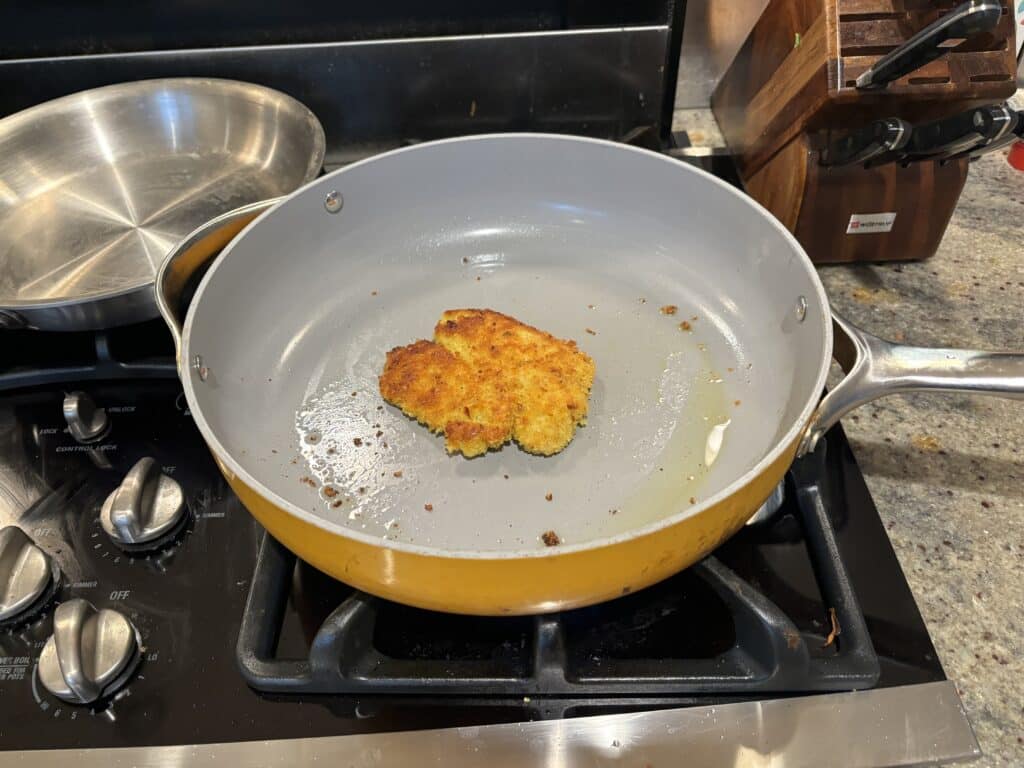
We’ve put Caraway’s cookware and bakeware through its paces for the last two years and know the products well. While the brand still makes the cut for our non-toxic cookware list, we have dropped Caraway cookware down a peg from a 5-leaf rating (our highest) to 4-leaves due to durability concerns.
The reality is that most of the online reviews about Caraway are pretty wishy-washy. We aren’t sure how The Spruce Eats, which titled its Caraway review “After three years of testing – we’re still sold on Caraway,” could possibly feel that way. We are coming up on two years of use, and the products show serious wear and tear. Unlike cast iron, carbon steel, and stainless cookware, Caraway’s ceramic-coated line is convenient but isn’t built to last.
We are disappointed that Caraway doesn’t use 3-ply construction. Because the surface beneath the ceramic coating is just aluminum and not an extra layer of stainless steel, you do risk exposing yourself to aluminum leaching when a significant amount of the ceramic wears away. Many less sustainable brands, including Hexclad, utilize 3-ply for their pans.
We continue to use Caraway and award them a solid leaf rating mainly because of their admirable transparency surrounding heavy metal testing and commitment to sustainability. The brand takes being PFOA and PTFE free seriously, and for that they should be applauded. Caraway could be a powerhouse with more attention paid to the way they manufacture their pans.
- Beautiful aesthetic
- Excellent eco-credentials
- PFOA, PTFE, and PFAS free
- Easy clean up
- Transparent (provided LeafScore with third party testing)
- Manufactured in China which means increased carbon footprint in shipping process
- Doesn’t last as long as cast iron or ceramic cookware
- Discoloration occurs soon after use
- Not 3-ply (ceramic-coated aluminum with a steel base)
The Caraway Cookware Set includes:
- Unique Caraway Storage Sytem
- 10.5″ Fry Pan
- 3 qt Sauce Pan
- 4.5 qt Sauté Pan
- 6.5 qt Dutch Oven
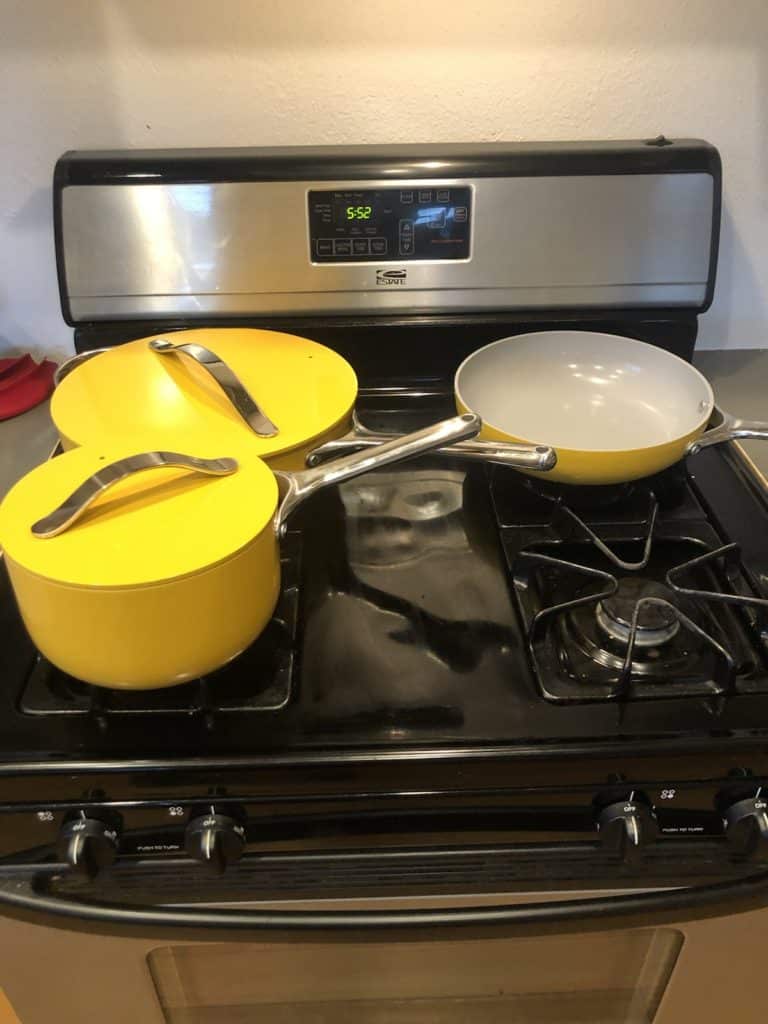
We used the Caraway cookware set to make:
- Pasta in the dutch oven
- Miso soup in the sauce pan
- Lamb, fish, eggs and oatmeal in the frying pan
In addition to the green street cred of these products, one of the biggest selling points for busy parents is the ease of clean up. Because the non-toxic cookware is truly non-stick, it is easy to clean the set with a quick wipe of a paper towel.
Caraway cookware products are light enough for kids and the elderly to use (much easier than cast iron). The downside is they aren’t built with 3-ply construction like Hexclad for example.
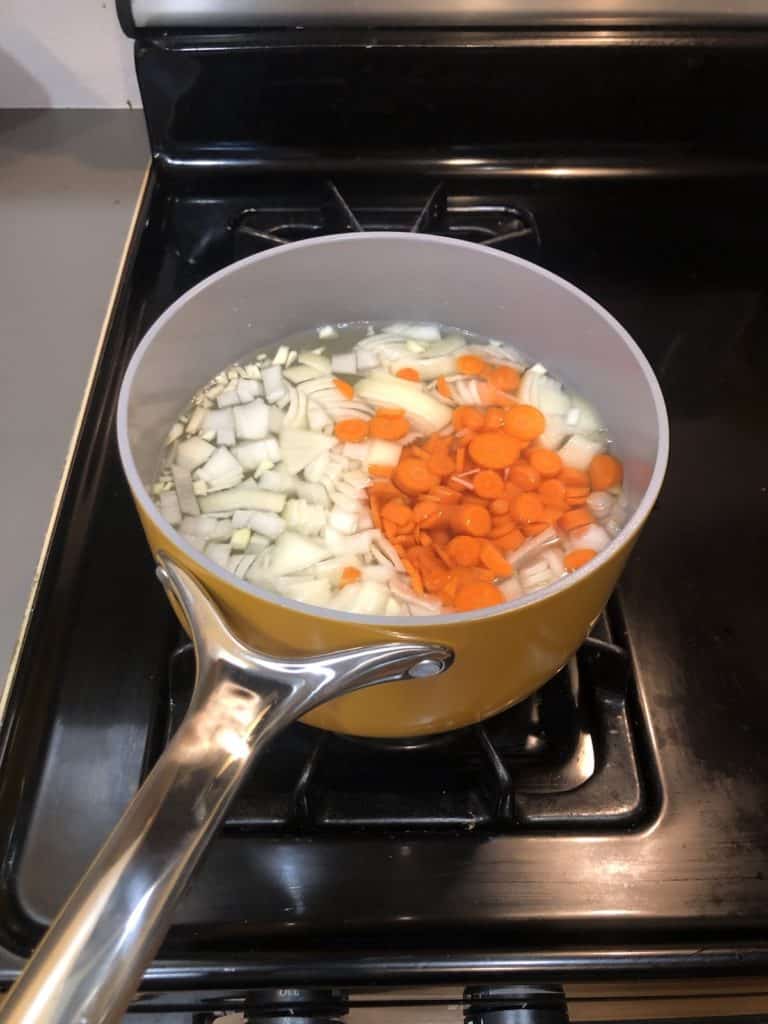
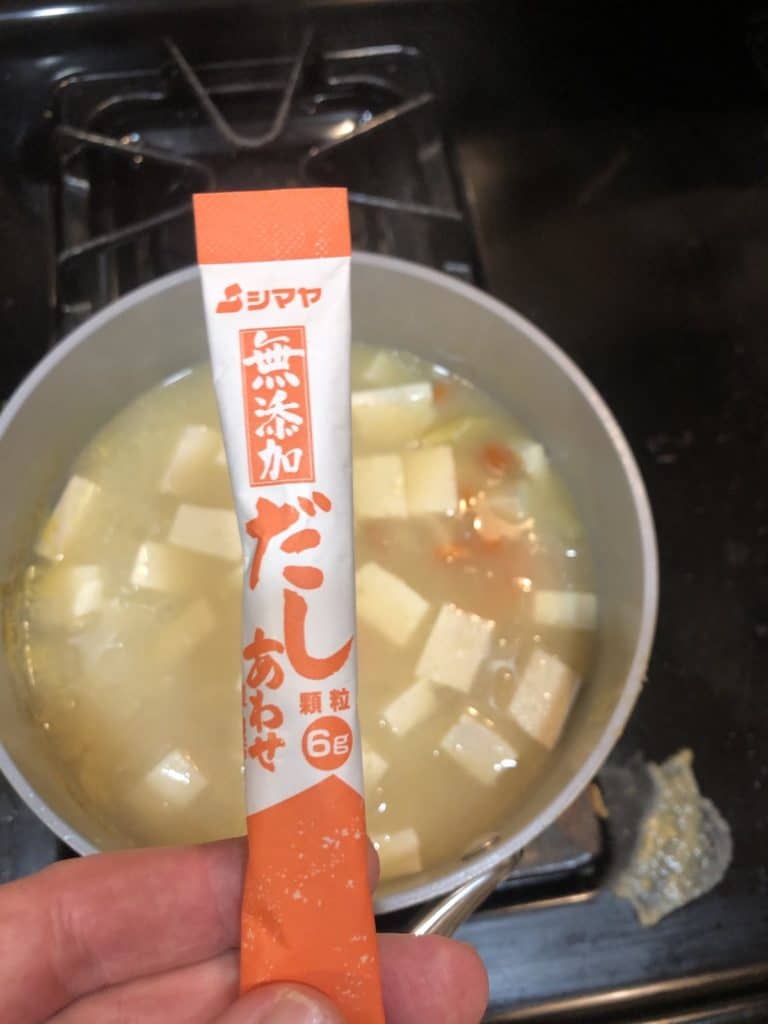
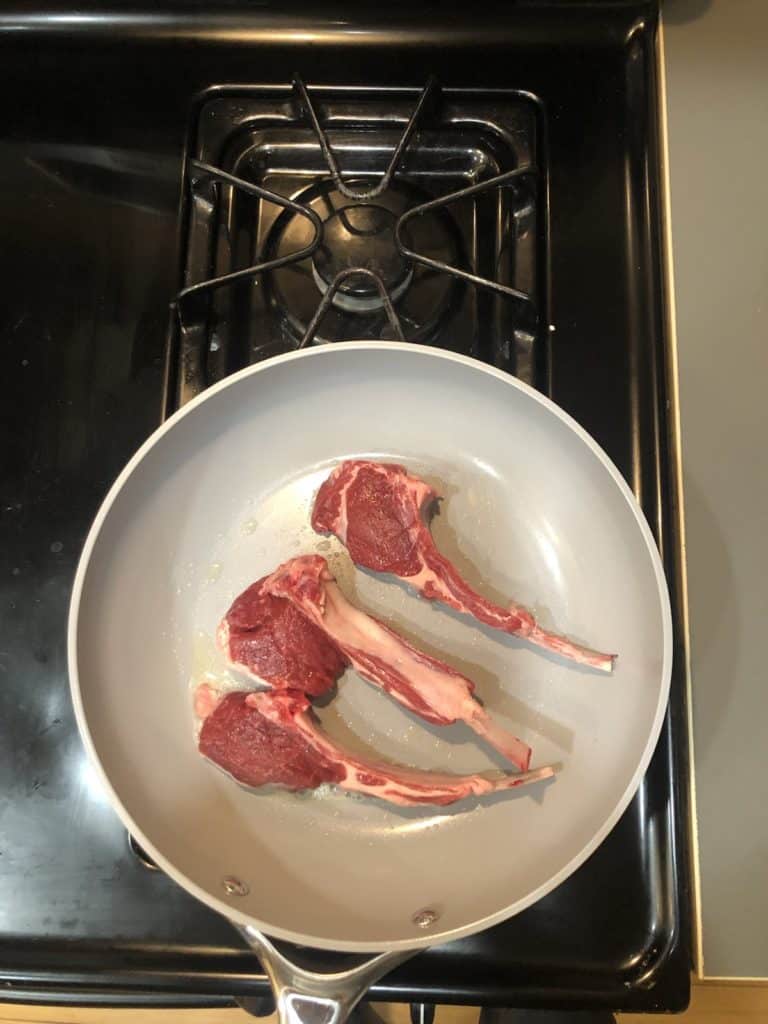
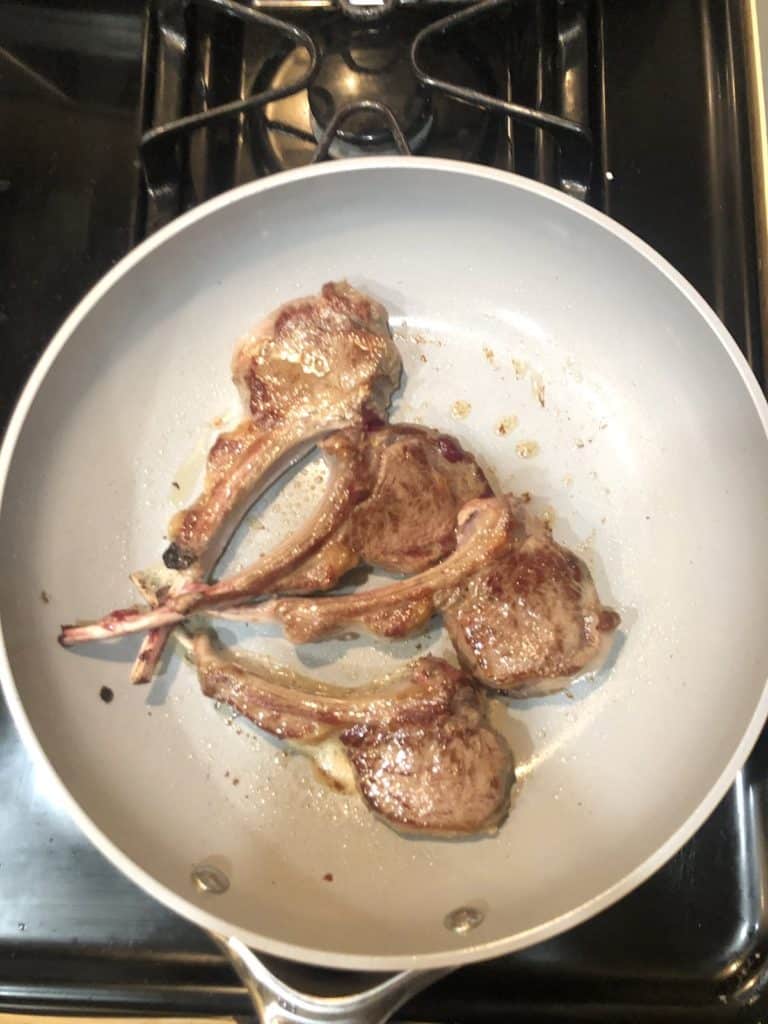
Chemical free but flimsy
- Non-stick cookware has a bad rap, and rightly so.
- Most non-stick pans and pots are made with ‘forever chemicals’ that off-gas toxic fumes during cooking, leach chemicals into food, and pollute the environment.
- They also tend not to last very long, meaning they have a bigger environmental footprint than, say, cast iron, carbon steel, or ceramic cookware.
- Caraway does things differently, at least when it comes to toxicity. This relatively new kitchenware brand only makes cookware and bakeware free of PFAS, PTFE, PFOA, and other toxic chemicals.
- Unfortunately, Caraway is built with flimsy construction, which means the products are not built to last
What is Caraway cookware made from?
Caraway uses a proprietary smooth ceramic coating to create a naturally non-stick surface over pots and pans made with an aluminum core and stainless steel base and handles. This means you can cook with minimal oil and still enjoy a non-stick experience (almost) comparable to toxic Teflon.
The downside is that this isn’t a 3-ply stainless steel pan coated with ceramic. Other cookware brands, such as GreenPan, make more substantial and longer-lasting pots and pans using 3-ply construction. Even Hexclad makes longer lasting pans, albeit ones with PTFE coatings.
See also: The best non-stick pans
Is Caraway’s marketing all hype and greenwashing though? Nope.
- I asked the company for copies of third-party testing and they immediately sent me the results of such for all their cookware.
- Every pot and pan passed with flying colors.
- This included passing California’s Prop 65 testing for lead and cadmium.
Test results showed no detectable PTFE, PFOA, lead, cadmium, chromium or other heavy metals. There was also no worrisome leaching of other chemicals of concern even when tested in acidic solutions to mimic cooking with, say, an acidic tomato sauce. Very small amounts of some metals were detected in the first and second use of a pan but these were completely undetectable by the third pass. As such, if you’re really concerned over exceptionally tiny amounts of aluminum, iron, manganese, magnesium, and so forth, you could simmer some orange juice in the pan for a while and then give it a good clean to get rid of any residual traces.
What makes Caraway different?
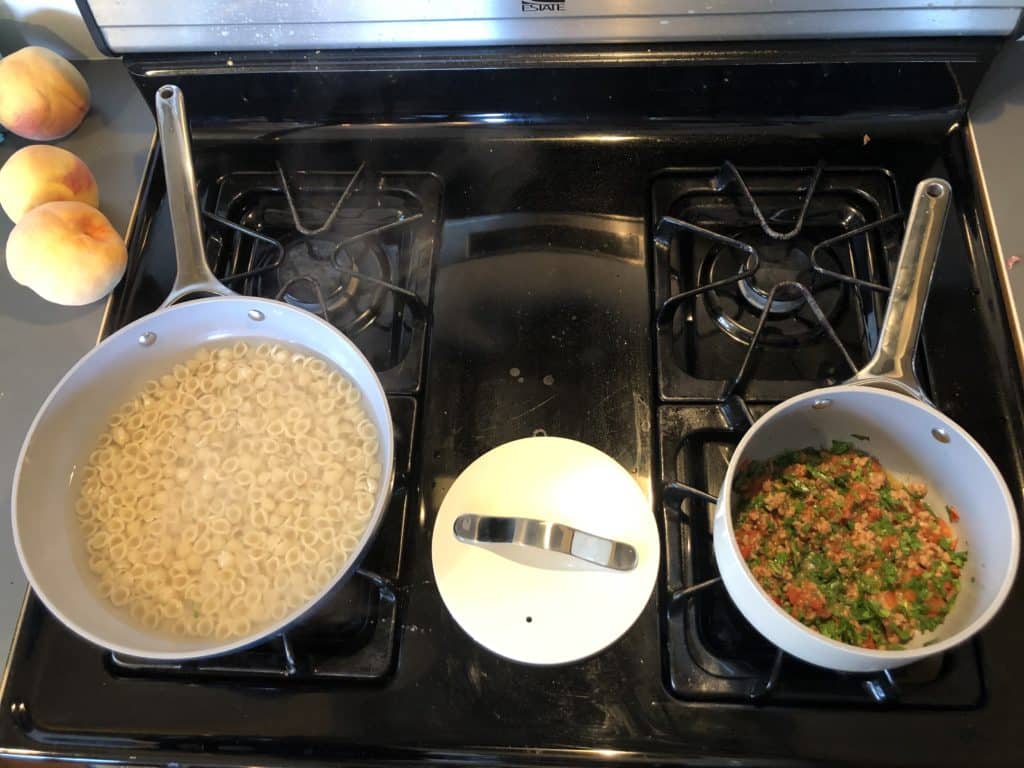
Caraway is also doing things a little differently to other cookware brands in that the company tracks its carbon emissions and monitors manufacturing processes to help it minimize the environmental footprint of its operations.
According to Caraway, the manufacture of its cookware “releases up to 60% less CO2 into the environment compared to traditional non-stick coatings.”
Caraway also uses manufacturing partners (in China) that are all BSCI and SMETA certified. This means employees are paid a fair wage, work regulated hours in safe conditions and are given benefits. We’d still like to see the pans made in North America though, or in Europe where working standards are higher.
Caraway cookware sets come with a specially designed pan rack and lid holder. If cupboards full of jumbled pots and pans are the bane of your kitchen life, you’re going to love Caraway. The only downside is that Caraway doesn’t offer the storage system by itself, even if you end up buying multiple pots and pans. That means, though, that it’s a great idea to just jump right in and get the whole cookware and bakeware set!
Caraway packaging is 100% recyclable and uses no plastic
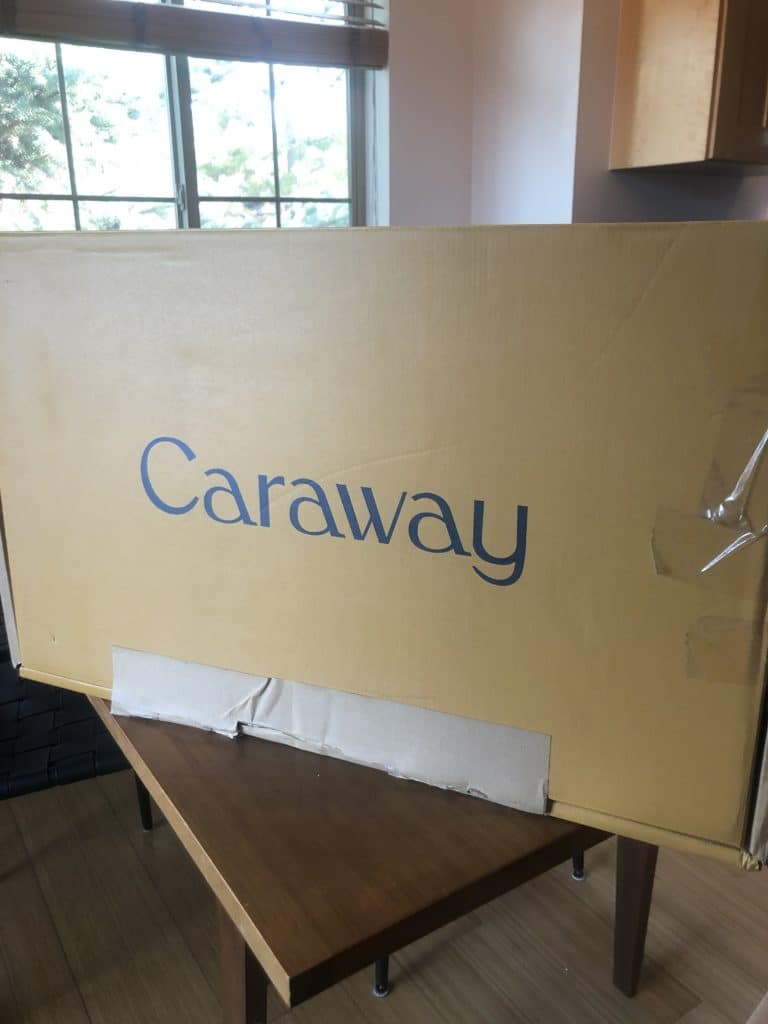
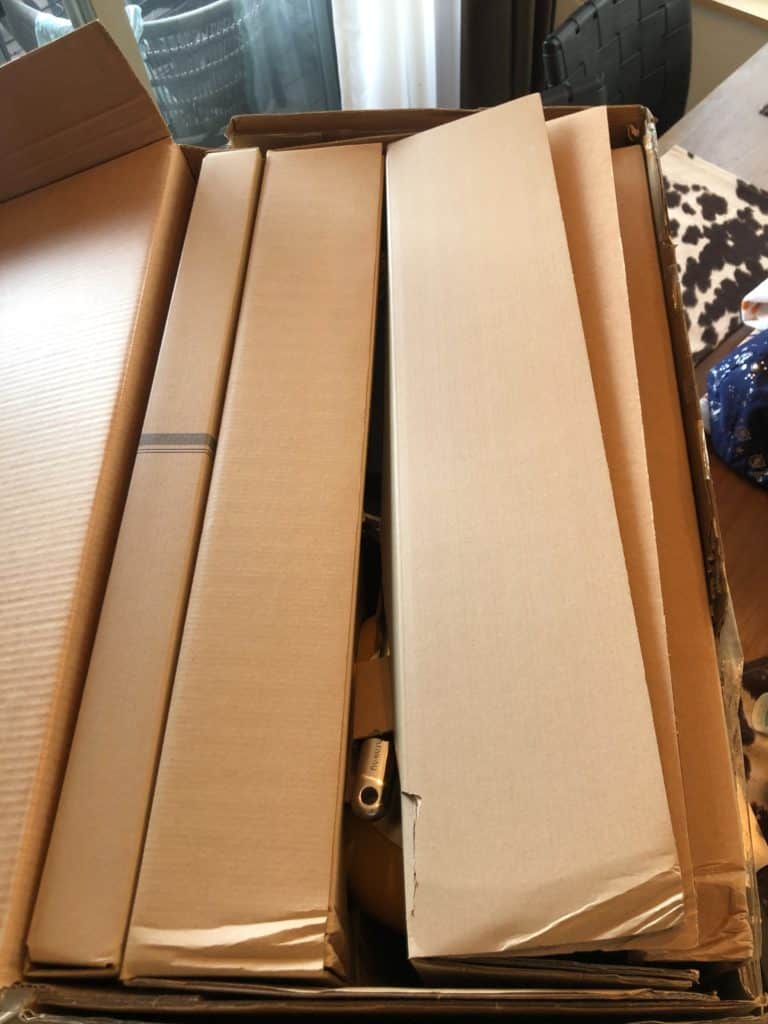
Finally, Caraway doesn’t use any single-use plastics in its packaging. Instead, it ships its products using packaging made from recycled cardboard and printed with biodegradable inks. Caraway even uses biodegradable cork trivets (which you can reuse) to safeguard the pots and pans.
And, if you’re ready to recycle your old pots and pans, Caraway helps with that too (indirectly). Pop your zip code into the company’s search engine to locate a recycling facility near you.
Don’t worry, you’re not missing a lid. The Dutch Oven and Sauce Pan share a lid, which is a great way of minimizing material use and cupboard space. In fact, the Caraway cookware set comes complete with convenient lid storage, which is perfect for smaller spaces, or for kitchens that prioritize organization. Keeping lids stored separately prevents scratching and dings and helps the set last longer.
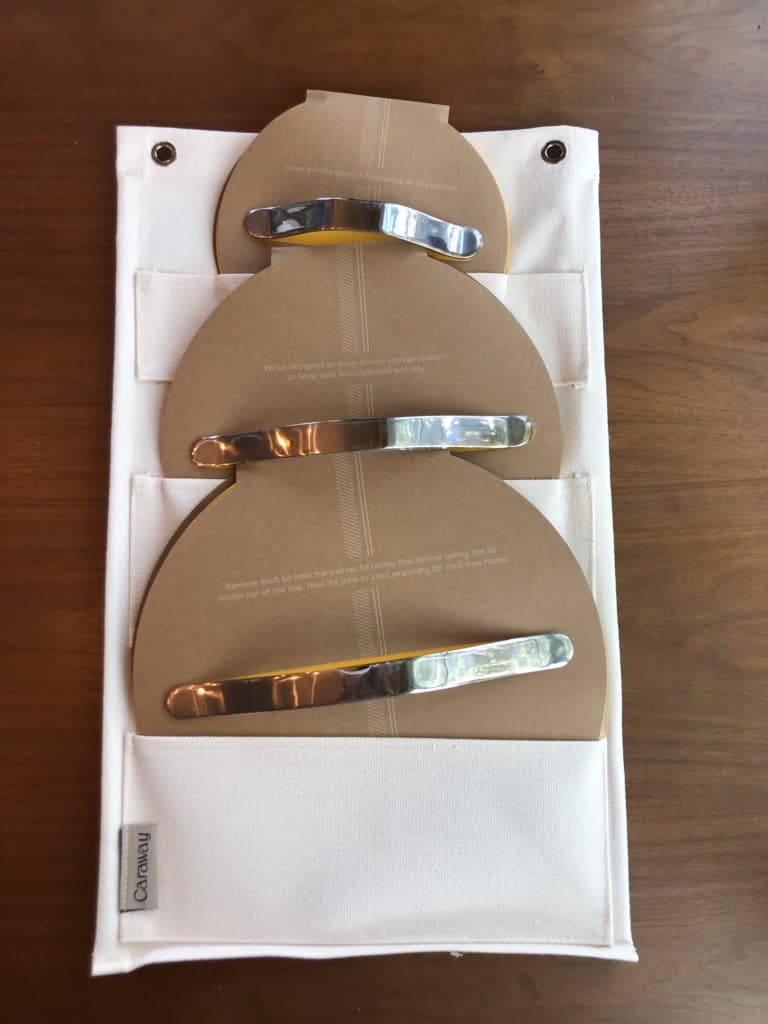
Things we love
Caraway cookware has a lot going for it. So much so that I’m envious John got to try it out and not me! Some of the things we love about Caraway cookware include:
- Non-stick and non-toxic – no PTFE or PFAS here! (third-party testing approved)
- Prop 65 tested and passed
- Lighter than cast iron or carbon steel
- Easy to clean (for longevity, it’s best to clean Caraway cookware by hand with non-abrasive materials and mild soap, though it is technically dishwasher safe)
- No need to season ceramic non-stick cookware – and no rusting!
- Minimal oil needed when cooking
- Gorgeous colorways, sure to fit every kitchen aesthetic
- Sustainably manufactured and packaged
- Ethically manufactured under fair working conditions
- Works with (most) induction cooktops
- Oven safe up to 550 degrees Fahrenheit
- Comes with its own smart storage solution (when purchasing the full set).
Caraway’s cookware is much lighter than cast iron and carbon steel. This makes Caraway a great choice for anyone who wants non-toxic cookware but struggles to lift heavy pots, pans, and bakeware. The ceramic-coated aluminum cookware is also free of lead, cadmium, and other toxic materials that can leach into food.
All in all, Caraway seems to be the real deal for non-toxic, non-stick cookware and gets a recommendation from the LeafScore team. Having said that, we do have some concerns, which are listed below.
Caraway cookware downsides
Overall, we give Caraway a positive review based on how convenient the products are, plus the transparency Caraway showed by providing us with the results of third-party tests.
The bottom line issue for many of our readers is whether Caraway is toxic or laden with heavy metals, and we give the brand a passing grade for these concerns.
However, there are some downsides to cooking with Caraway.
First, the lovely aesthetic and bright colors rapidly diminishes as the cookware is put to use. No matter the color, expect some degree of discoloration with your Caraway set, especially the bottoms of pots and pans, which show burnt discoloration marks soon after use, especially on gas cooktops.
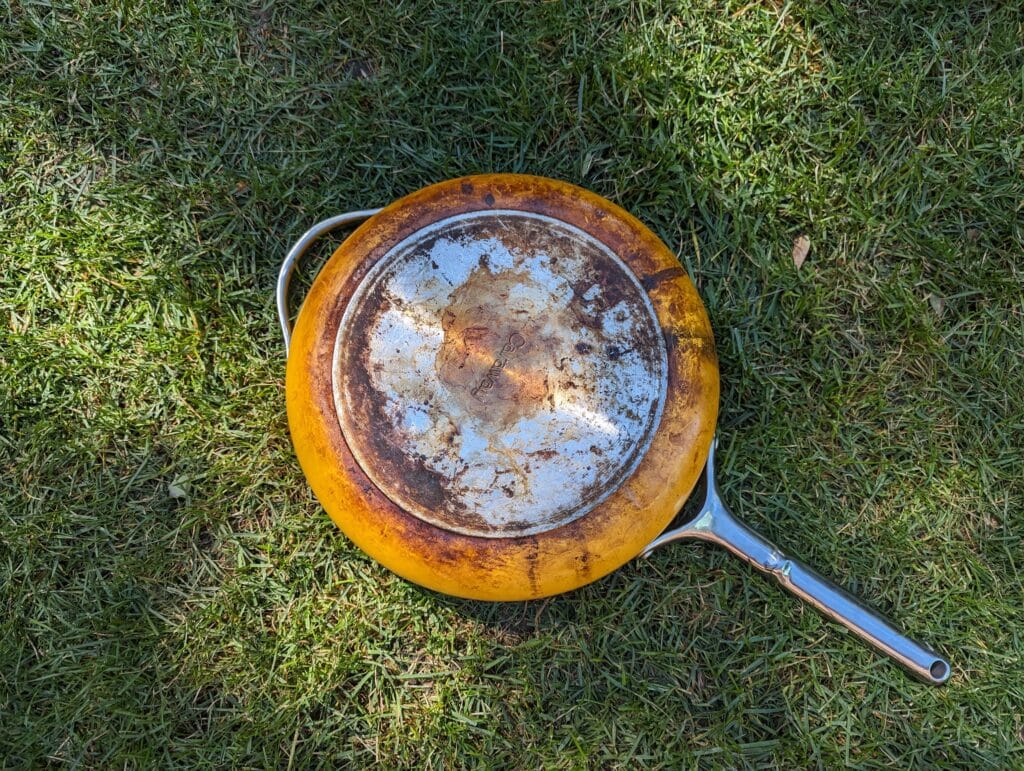
Another issue dog owners should be aware of. If you’re like us, you like to treat your canine family members with a dirty pan to “clean,” Caraway isn’t the brand for you. Our dog, Ned, caused some small scratches in the frying pan’s coating with his licking and biting.
Unfortunately, we have reason to believe that the damage our dog caused by licking the pans revealed a larger issue. With normal use for just one year, other products in the Caraway Cookware set began to show small chips in the coating, even with normal, non-canine use. We have included a photo below. If you look closely, it’s possible to see the cracks in Caraway’s non-stick coating.
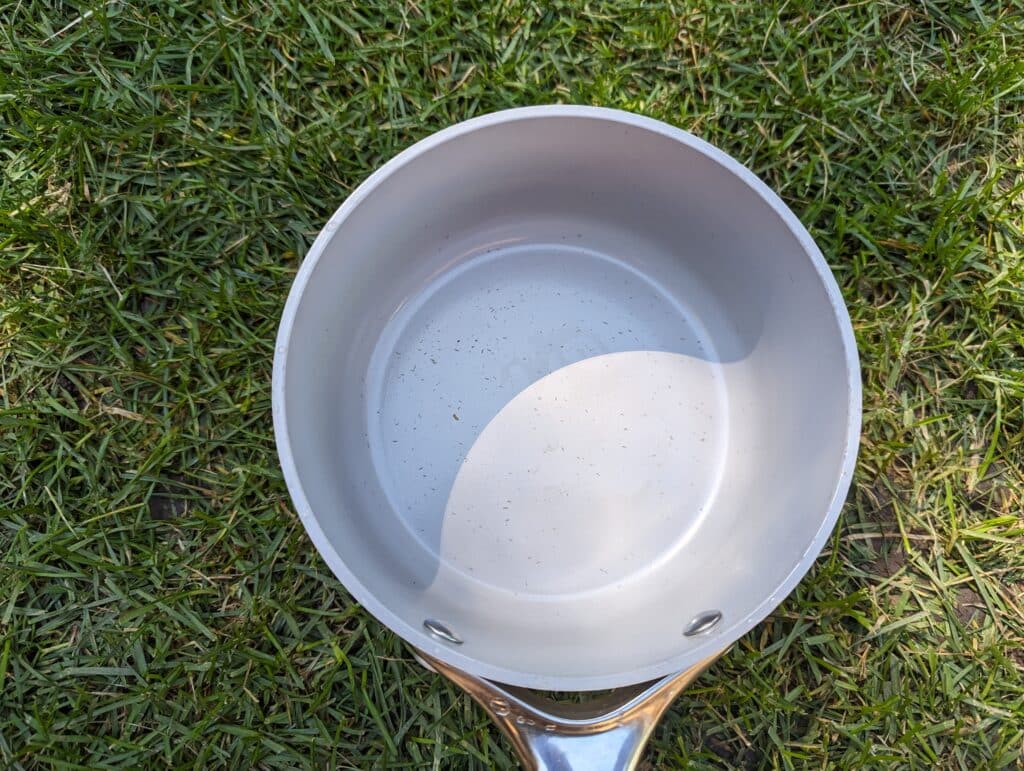
Those cracks and chips aren’t a huge problem, at least at first. It’s still safe to cook with Caraway pots and pans that have a few small scratches. However, because the surface beneath the ceramic coating is just aluminum, not stainless steel, you do risk exposing yourself to aluminum leaching when a significant amount of the ceramic wears away.
If you’re unsure of the status of your pan, do an aluminum leach test at home, using this method.
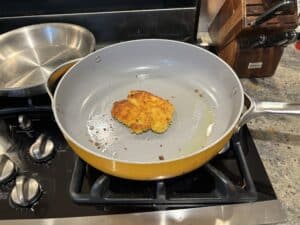
Caraway Cookware
Highlights: Non-toxic, non-stick, LeafScore tried and tested cookware. Works with induction, gas, and electric stovetops, is oven-safe, easy to clean, and very easy on the eyes – available in nearly a dozen color options!
Caraway cookware FAQ
Because Caraway is free of toxic Teflon and other chemicals of concern, and doesn’t contain any plastic or silicon components, it’s also oven safe up to 550 degrees Fahrenheit. And, despite being mostly aluminum coated with ceramic, the pots and pans are also usable on most induction cooktops because of that stainless steel base.
Caraway cookware and bakeware comes with a limited one-year warranty. This covers any major damage to the body, handles, lids, or anything else that impairs the function of the cookware.
For brands that we feel meet, or exceed, the standard set by Caraway, have a look at our post on the best non-toxic non-stick pans, as well as the best non-toxic cookware. One new brand to come on our radar lately is Alva cookware, another company we have tested first-hand and awarded 5-leaves.
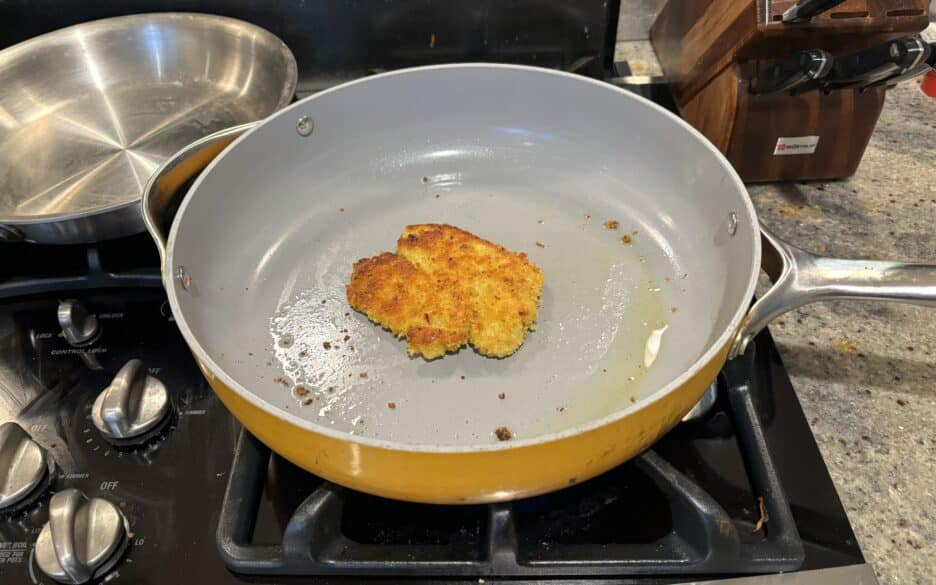
Which caraway set is this? The pan reflects lead, mercury, acrimony, cadmium, and several other heavy metals in the XRF lab report. Are they actually non-toxic or is leaf score permitting greenwashing?
Hi Melissa,
Thanks for the questions! Please see our article on Caraway and greenwashing!
Leigh
Is Caraways’s “proprietary coating” really any better than something like Thermolon? There is really no mention in this page of potential chemicals like silanes used in this coating, and the coating for ceramic pans is the problem area.
James, we delve into that issue in this blog: https://www.leafscore.com/eco-friendly-kitchen-products/answering-reader-questions-about-caraway-cookware-and-greenwashing/